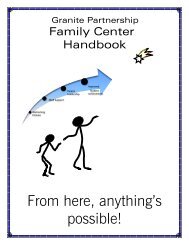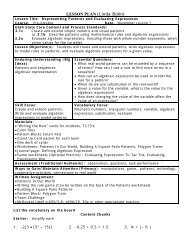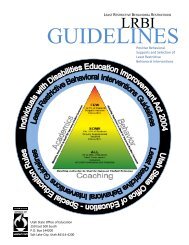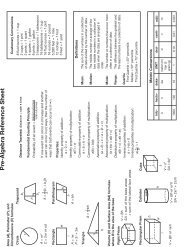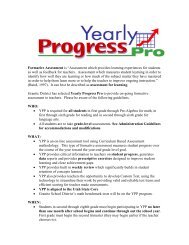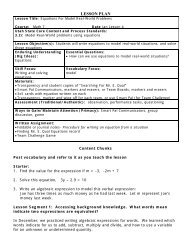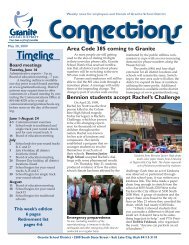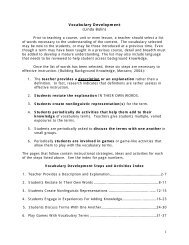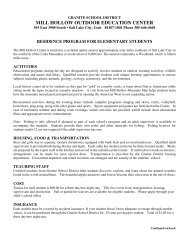Utah Special Education Paraeducator Handbook - Granite School ...
Utah Special Education Paraeducator Handbook - Granite School ...
Utah Special Education Paraeducator Handbook - Granite School ...
You also want an ePaper? Increase the reach of your titles
YUMPU automatically turns print PDFs into web optimized ePapers that Google loves.
cycle (lesson plan) which gives students many opportunities to respond, then provides feedback on their<br />
responses<br />
This is often called the Effective Teaching Cycle. It includes the following steps.<br />
Opening: The opening of a lesson is used to:<br />
<br />
<br />
<br />
<br />
<br />
<br />
gain student(s) attention<br />
present an overview of the lesson<br />
share expectations<br />
provide a rationale or reason why the lesson is<br />
important<br />
activate student background knowledge<br />
provide a review of any concepts that are<br />
important for the current lesson.<br />
Effective Teaching Cycle<br />
Lesson and Demonstration (I do): In this section of the<br />
lesson, new material is taught. The instructor may spend<br />
a small portion of the time lecturing or describing<br />
procedures. After the new material is discussed, the<br />
instructor models the new skill or strategy from<br />
beginning to end. Once the skill is demonstrated, the<br />
instructor will tell the student(s) to imitate or practice the skill.<br />
When modeling skills or behaviors for students, the instructor should:<br />
<br />
<br />
<br />
tell the student what step in the skill sequence is being modeled<br />
clearly and unambiguously perform the skill<br />
check for understanding<br />
include non-examples only after students are clear on the concept being modeled.<br />
Always finish with a correct model. Students tend to remember the last piece of information given.<br />
Guided Practice (We do): In this section of the lesson students practice new skills with assistance.<br />
Corrective feedback is crucial during guided practice. Students need to know what they are doing right<br />
as much as they need to know what they are doing wrong. If students make an error, the instructor<br />
needs to model the skill again, and then have the student complete the skill correctly. If the student is<br />
correct, it is important to praise the student. (See the Appendix for 101 ways to praise students.)<br />
During this stage of the lesson, instructors should:<br />
<br />
<br />
<br />
<br />
<br />
Encourage students to verbalize their actions as they progress through the skill.<br />
Closely observe students as they perform the skill so errors can be prevented.<br />
Give ample opportunities for students to perform the skill correctly.<br />
Stop errors immediately and provide corrective feedback.<br />
Don’t forget to praise, PRAISE, PRAISE!!!<br />
<strong>Utah</strong> <strong>Paraeducator</strong> <strong>Handbook</strong> Page 7




